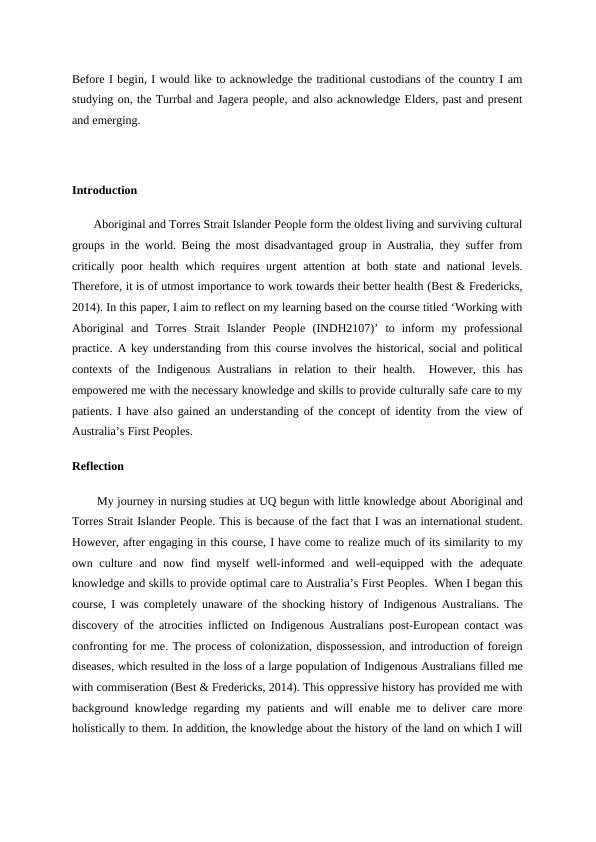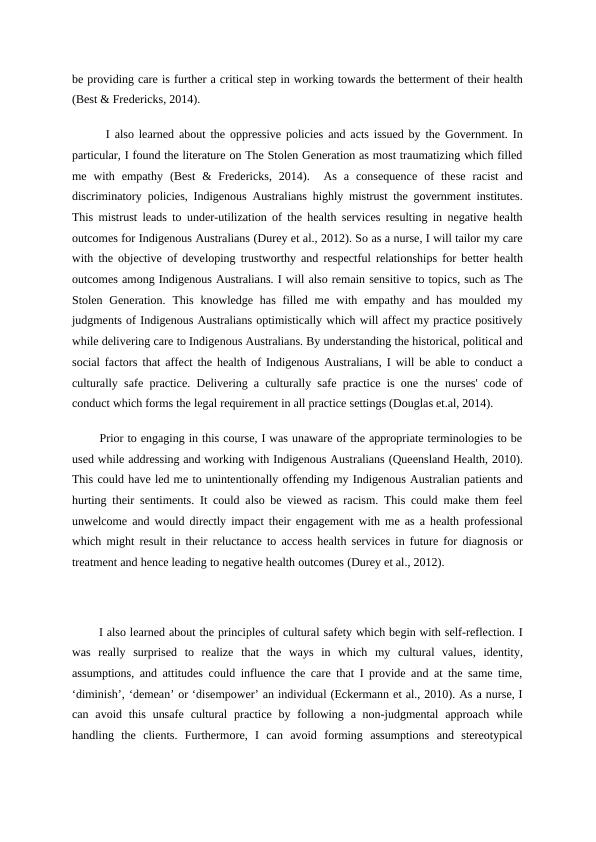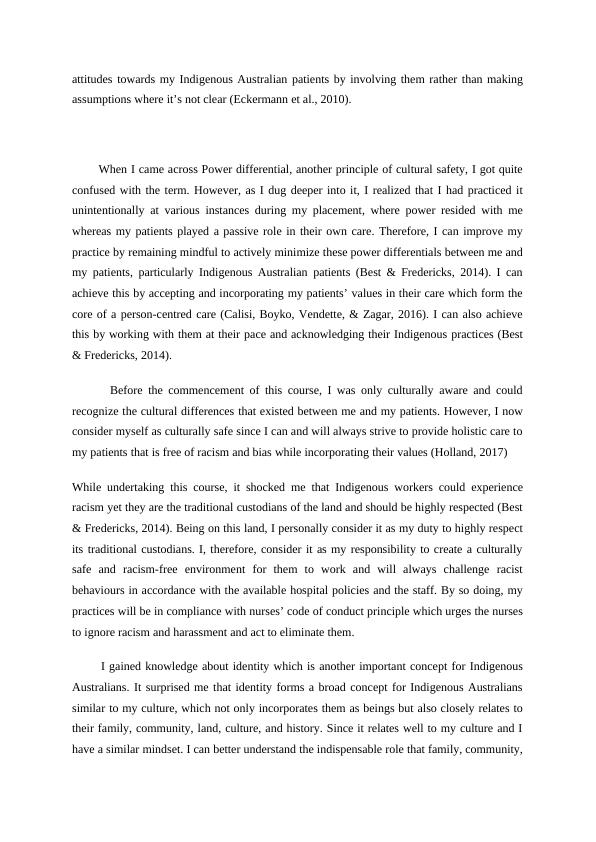Ask a question from expert
traditional custodians Assignment PDF
6 Pages2426 Words78 Views
Added on 2021-10-05
traditional custodians Assignment PDF
Added on 2021-10-05
BookmarkShareRelated Documents
Before I begin, I would like to acknowledge the traditional custodians of the country I am
studying on, the Turrbal and Jagera people, and also acknowledge Elders, past and present
and emerging.
Introduction
Aboriginal and Torres Strait Islander People form the oldest living and surviving cultural
groups in the world. Being the most disadvantaged group in Australia, they suffer from
critically poor health which requires urgent attention at both state and national levels.
Therefore, it is of utmost importance to work towards their better health (Best & Fredericks,
2014). In this paper, I aim to reflect on my learning based on the course titled ‘Working with
Aboriginal and Torres Strait Islander People (INDH2107)’ to inform my professional
practice. A key understanding from this course involves the historical, social and political
contexts of the Indigenous Australians in relation to their health. However, this has
empowered me with the necessary knowledge and skills to provide culturally safe care to my
patients. I have also gained an understanding of the concept of identity from the view of
Australia’s First Peoples.
Reflection
My journey in nursing studies at UQ begun with little knowledge about Aboriginal and
Torres Strait Islander People. This is because of the fact that I was an international student.
However, after engaging in this course, I have come to realize much of its similarity to my
own culture and now find myself well-informed and well-equipped with the adequate
knowledge and skills to provide optimal care to Australia’s First Peoples. When I began this
course, I was completely unaware of the shocking history of Indigenous Australians. The
discovery of the atrocities inflicted on Indigenous Australians post-European contact was
confronting for me. The process of colonization, dispossession, and introduction of foreign
diseases, which resulted in the loss of a large population of Indigenous Australians filled me
with commiseration (Best & Fredericks, 2014). This oppressive history has provided me with
background knowledge regarding my patients and will enable me to deliver care more
holistically to them. In addition, the knowledge about the history of the land on which I will
studying on, the Turrbal and Jagera people, and also acknowledge Elders, past and present
and emerging.
Introduction
Aboriginal and Torres Strait Islander People form the oldest living and surviving cultural
groups in the world. Being the most disadvantaged group in Australia, they suffer from
critically poor health which requires urgent attention at both state and national levels.
Therefore, it is of utmost importance to work towards their better health (Best & Fredericks,
2014). In this paper, I aim to reflect on my learning based on the course titled ‘Working with
Aboriginal and Torres Strait Islander People (INDH2107)’ to inform my professional
practice. A key understanding from this course involves the historical, social and political
contexts of the Indigenous Australians in relation to their health. However, this has
empowered me with the necessary knowledge and skills to provide culturally safe care to my
patients. I have also gained an understanding of the concept of identity from the view of
Australia’s First Peoples.
Reflection
My journey in nursing studies at UQ begun with little knowledge about Aboriginal and
Torres Strait Islander People. This is because of the fact that I was an international student.
However, after engaging in this course, I have come to realize much of its similarity to my
own culture and now find myself well-informed and well-equipped with the adequate
knowledge and skills to provide optimal care to Australia’s First Peoples. When I began this
course, I was completely unaware of the shocking history of Indigenous Australians. The
discovery of the atrocities inflicted on Indigenous Australians post-European contact was
confronting for me. The process of colonization, dispossession, and introduction of foreign
diseases, which resulted in the loss of a large population of Indigenous Australians filled me
with commiseration (Best & Fredericks, 2014). This oppressive history has provided me with
background knowledge regarding my patients and will enable me to deliver care more
holistically to them. In addition, the knowledge about the history of the land on which I will

be providing care is further a critical step in working towards the betterment of their health
(Best & Fredericks, 2014).
I also learned about the oppressive policies and acts issued by the Government. In
particular, I found the literature on The Stolen Generation as most traumatizing which filled
me with empathy (Best & Fredericks, 2014). As a consequence of these racist and
discriminatory policies, Indigenous Australians highly mistrust the government institutes.
This mistrust leads to under-utilization of the health services resulting in negative health
outcomes for Indigenous Australians (Durey et al., 2012). So as a nurse, I will tailor my care
with the objective of developing trustworthy and respectful relationships for better health
outcomes among Indigenous Australians. I will also remain sensitive to topics, such as The
Stolen Generation. This knowledge has filled me with empathy and has moulded my
judgments of Indigenous Australians optimistically which will affect my practice positively
while delivering care to Indigenous Australians. By understanding the historical, political and
social factors that affect the health of Indigenous Australians, I will be able to conduct a
culturally safe practice. Delivering a culturally safe practice is one the nurses' code of
conduct which forms the legal requirement in all practice settings (Douglas et.al, 2014).
Prior to engaging in this course, I was unaware of the appropriate terminologies to be
used while addressing and working with Indigenous Australians (Queensland Health, 2010).
This could have led me to unintentionally offending my Indigenous Australian patients and
hurting their sentiments. It could also be viewed as racism. This could make them feel
unwelcome and would directly impact their engagement with me as a health professional
which might result in their reluctance to access health services in future for diagnosis or
treatment and hence leading to negative health outcomes (Durey et al., 2012).
I also learned about the principles of cultural safety which begin with self-reflection. I
was really surprised to realize that the ways in which my cultural values, identity,
assumptions, and attitudes could influence the care that I provide and at the same time,
‘diminish’, ‘demean’ or ‘disempower’ an individual (Eckermann et al., 2010). As a nurse, I
can avoid this unsafe cultural practice by following a non-judgmental approach while
handling the clients. Furthermore, I can avoid forming assumptions and stereotypical
(Best & Fredericks, 2014).
I also learned about the oppressive policies and acts issued by the Government. In
particular, I found the literature on The Stolen Generation as most traumatizing which filled
me with empathy (Best & Fredericks, 2014). As a consequence of these racist and
discriminatory policies, Indigenous Australians highly mistrust the government institutes.
This mistrust leads to under-utilization of the health services resulting in negative health
outcomes for Indigenous Australians (Durey et al., 2012). So as a nurse, I will tailor my care
with the objective of developing trustworthy and respectful relationships for better health
outcomes among Indigenous Australians. I will also remain sensitive to topics, such as The
Stolen Generation. This knowledge has filled me with empathy and has moulded my
judgments of Indigenous Australians optimistically which will affect my practice positively
while delivering care to Indigenous Australians. By understanding the historical, political and
social factors that affect the health of Indigenous Australians, I will be able to conduct a
culturally safe practice. Delivering a culturally safe practice is one the nurses' code of
conduct which forms the legal requirement in all practice settings (Douglas et.al, 2014).
Prior to engaging in this course, I was unaware of the appropriate terminologies to be
used while addressing and working with Indigenous Australians (Queensland Health, 2010).
This could have led me to unintentionally offending my Indigenous Australian patients and
hurting their sentiments. It could also be viewed as racism. This could make them feel
unwelcome and would directly impact their engagement with me as a health professional
which might result in their reluctance to access health services in future for diagnosis or
treatment and hence leading to negative health outcomes (Durey et al., 2012).
I also learned about the principles of cultural safety which begin with self-reflection. I
was really surprised to realize that the ways in which my cultural values, identity,
assumptions, and attitudes could influence the care that I provide and at the same time,
‘diminish’, ‘demean’ or ‘disempower’ an individual (Eckermann et al., 2010). As a nurse, I
can avoid this unsafe cultural practice by following a non-judgmental approach while
handling the clients. Furthermore, I can avoid forming assumptions and stereotypical

attitudes towards my Indigenous Australian patients by involving them rather than making
assumptions where it’s not clear (Eckermann et al., 2010).
When I came across Power differential, another principle of cultural safety, I got quite
confused with the term. However, as I dug deeper into it, I realized that I had practiced it
unintentionally at various instances during my placement, where power resided with me
whereas my patients played a passive role in their own care. Therefore, I can improve my
practice by remaining mindful to actively minimize these power differentials between me and
my patients, particularly Indigenous Australian patients (Best & Fredericks, 2014). I can
achieve this by accepting and incorporating my patients’ values in their care which form the
core of a person-centred care (Calisi, Boyko, Vendette, & Zagar, 2016). I can also achieve
this by working with them at their pace and acknowledging their Indigenous practices (Best
& Fredericks, 2014).
Before the commencement of this course, I was only culturally aware and could
recognize the cultural differences that existed between me and my patients. However, I now
consider myself as culturally safe since I can and will always strive to provide holistic care to
my patients that is free of racism and bias while incorporating their values (Holland, 2017)
While undertaking this course, it shocked me that Indigenous workers could experience
racism yet they are the traditional custodians of the land and should be highly respected (Best
& Fredericks, 2014). Being on this land, I personally consider it as my duty to highly respect
its traditional custodians. I, therefore, consider it as my responsibility to create a culturally
safe and racism-free environment for them to work and will always challenge racist
behaviours in accordance with the available hospital policies and the staff. By so doing, my
practices will be in compliance with nurses’ code of conduct principle which urges the nurses
to ignore racism and harassment and act to eliminate them.
I gained knowledge about identity which is another important concept for Indigenous
Australians. It surprised me that identity forms a broad concept for Indigenous Australians
similar to my culture, which not only incorporates them as beings but also closely relates to
their family, community, land, culture, and history. Since it relates well to my culture and I
have a similar mindset. I can better understand the indispensable role that family, community,
assumptions where it’s not clear (Eckermann et al., 2010).
When I came across Power differential, another principle of cultural safety, I got quite
confused with the term. However, as I dug deeper into it, I realized that I had practiced it
unintentionally at various instances during my placement, where power resided with me
whereas my patients played a passive role in their own care. Therefore, I can improve my
practice by remaining mindful to actively minimize these power differentials between me and
my patients, particularly Indigenous Australian patients (Best & Fredericks, 2014). I can
achieve this by accepting and incorporating my patients’ values in their care which form the
core of a person-centred care (Calisi, Boyko, Vendette, & Zagar, 2016). I can also achieve
this by working with them at their pace and acknowledging their Indigenous practices (Best
& Fredericks, 2014).
Before the commencement of this course, I was only culturally aware and could
recognize the cultural differences that existed between me and my patients. However, I now
consider myself as culturally safe since I can and will always strive to provide holistic care to
my patients that is free of racism and bias while incorporating their values (Holland, 2017)
While undertaking this course, it shocked me that Indigenous workers could experience
racism yet they are the traditional custodians of the land and should be highly respected (Best
& Fredericks, 2014). Being on this land, I personally consider it as my duty to highly respect
its traditional custodians. I, therefore, consider it as my responsibility to create a culturally
safe and racism-free environment for them to work and will always challenge racist
behaviours in accordance with the available hospital policies and the staff. By so doing, my
practices will be in compliance with nurses’ code of conduct principle which urges the nurses
to ignore racism and harassment and act to eliminate them.
I gained knowledge about identity which is another important concept for Indigenous
Australians. It surprised me that identity forms a broad concept for Indigenous Australians
similar to my culture, which not only incorporates them as beings but also closely relates to
their family, community, land, culture, and history. Since it relates well to my culture and I
have a similar mindset. I can better understand the indispensable role that family, community,

End of preview
Want to access all the pages? Upload your documents or become a member.
Related Documents
Historical Impacts on Aboriginal and Torres Strait Islander Peoplelg...
|23
|1925
|90
Determinants of Healthlg...
|6
|1217
|352
Reflection on Social or Health Issue: Nursing Assignmentlg...
|11
|2771
|42
Views and History of Aboriginals and Torres Strait Islander Peoplelg...
|6
|1286
|143
Stolen Generations of Australialg...
|11
|2878
|405
Culturally Safe Practice for Aboriginal and Torres Strait Islander Populationlg...
|13
|3474
|95